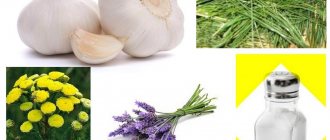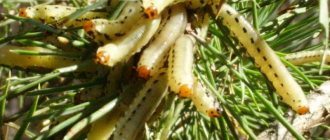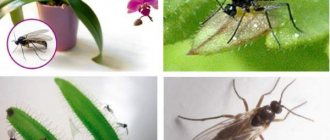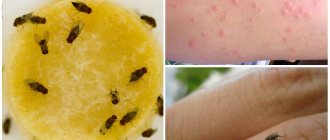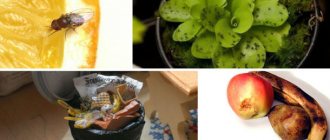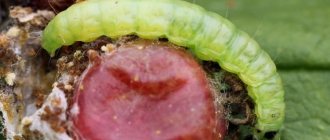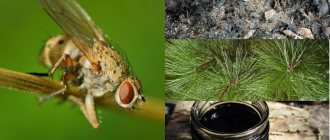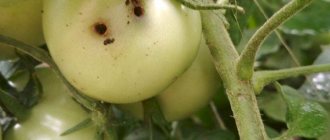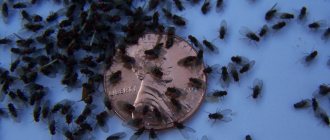28.02.2017
For the harvest, the gardener has to compete with the vagaries of the weather and with parasitic insects. Tomato lovers get it from the black midge or, as it is also called, the country aphid or leafhopper. If you don’t get rid of it in time, the tomato midge will destroy the beds with tomatoes.
- Damage from black midges
- How to get rid of black midges on tomatoes
- How to get rid of black midges on tomato seedlings
What are black midges and why are they dangerous?
Black midges are a type of plant aphid, which is called black aphids (along with brown, white, green and others). These are small insects with a soft, round body (diameter from 1 to 5 mm). They feed on the juices of green tissues of tomatoes and other plants, piercing holes on the surface with the help of their proboscis. They multiply quickly and move to neighboring plants.
The danger of the pest is that it not only parasitizes the tomato, but also carries dangerous pathogens:
- late blight (leaves curl, black necrotic spots appear on tomatoes);
- stolbur (deformation of leaves and inflorescences);
- viral infections (curling, spots on leaves, wilting of the plant).
Black midges first settle on weeds, mainly on quinoa, after which they quickly fall on tomatoes. Therefore, it is advisable to detect them as early as possible, and then immediately begin destruction.
Attention!
The pest multiplies quickly and also contributes to the infection of tomatoes with dangerous diseases. Therefore, if you do nothing, you can lose a significant part of the harvest.
Already at the beginning of June, the first individuals appear (immediately with wings), and if not treated, the tomato bushes seem to freeze in development and almost do not grow. Clickable photo:
How to prevent aphid attacks
The most effective is the use of systemic insecticides. Two sprayings per season completely eliminate aphid attacks. At the same time, the preparations are not washed off by rain, are not afraid of sunlight and heat, and act against all pests. But if you do not want to use such radical means, then simply plant the garden bed with plants that aphids do not like. These are garlic and onions. Such a natural curtain can repel the pest. For the same purpose, jars with infusion of garlic and onions are placed along the edges of the bed. Do not forget that private feeding stimulates the growth of weeds, the young shoots of which are a tasty prey for aphids. Therefore, you should not overuse fertilizing either. All weeds must be carefully weeded out.
What to do if folk remedies don’t help
If the insect colony is too large, you will have to use insecticides. In this case, the following biological products are effective:
- "Fitoverm";
- "Akarin."
Chemicals:
- "Biotlin";
- "Fufanon."
Before processing, the drug is diluted in water and then acted according to the instructions. You should not expect a significant effect in the first days - as a rule, the result becomes noticeable after 4 days.
Warning:
After using chemicals, after 3-4 days, it is advisable to spray the bushes with clean water to wash off the remaining solution. The harvest can be harvested no earlier than the waiting period (it is always indicated in the instructions, usually 2-3 days).
After several trials, we settled on dectar soap - it is very effective, it helps from the first spray. And since at this time the tomatoes are already blooming, we add boron chelate to the sprayer - it turns out 2 in 1 - and protection and fertilizing with a microelement for better fruit set.
Saving seedlings
Due to too much watering in cold weather, midges can appear on tomato seedlings. To combat it, folk remedies will help, since chemicals are harmful to young shoots.
Tomato seedlings should be watered with a slightly pink solution of potassium permanganate, or 1 tablespoon of vinegar diluted in a liter of water.
Many gardeners, in order to avoid the appearance of midges on young shoots, sprinkle ash on top of the soil in pots. Insects will not be able to hide in the ground and lay eggs.
Measures to prevent the appearance of black midges
You can prevent the appearance of the pest in simple ways by planting between rows of tomatoes, as well as near the garden bed:
- onion;
- garlic;
- tansy;
- marigold;
- sweet pea;
- daisies;
- marjoram;
- lavender.
These fragrant plants, on the one hand, repel pests. On the other hand, they attract ladybugs that eat aphids. You can also specially purchase several dozen cows from suppliers. But they need to be released late in the evening into a well-moistened garden. Moreover, they will take root there only if there are a lot of aphids and midges on the leaves.
Thus, it is possible and necessary to fight midges. To do this, first of all, it is worth using folk remedies. Insecticides are dangerous to beneficial insects, and heavy elements can remain in the soil for a long time. Moreover, the sooner you start processing, the faster you will deal with black midges on tomatoes.
Removing the tomato mosquito
Measures against the pest should be aimed at destroying the larvae and scaring off adult individuals from planting in order to prevent the laying of eggs in the ground near the roots of plants.
Advice! If midges appear on seedlings, bury a clove of garlic or a pinch of crushed tobacco in each container.
To remove adult tomato gnats, the use of pesticides is not justified - it is enough to let the top layer of soil dry and set traps for mechanical destruction of the midges. Yellow cardboards greased with honey, vegetable oil, Vaseline or other viscous and sticky substance are used as traps, replacing them periodically.
Spraying with folk remedies
You can scare away midges from planting by treating the bushes with decoctions and infusions with a strong aroma. Infusions of vinegar, pepper and mustard, which are used to remove winged aphids, are suitable. In addition, the fungus gnat does not like:
- Dandelion. Crushed leaves, stems and roots of dandelion are poured with water at the rate of 1 kg per bucket. They insist for about a day. The product acts against both adults and larvae if you pour it on the tree trunk.
- Garlic. 2 crushed heads of garlic are poured with a liter of water and left for 5 days. Before use, dilute with 5 liters of water.
- Onion. 650 g of onion peels need to be poured with 10 liters of boiling water. After cooling, the infusion can be used to spray the bushes.
- Tomato tops. Grind the tomato leaves and add hot water (20 tablespoons of raw material per 5 liters of water). It should be left for 12 hours.
Soil treatment
Tomato mosquito larvae die in dry soil, so to destroy them it is enough to stop watering the planting for a while. But during the flowering period of tomatoes, this measure should be used with caution - a lack of water can cause the ovaries to fall off. An alternative and safer option is dusting the beds with wood ash.
To destroy a large population of black midge larvae, insecticides against soil pests are used:
- “Bazudin” – lasts about 1.5 months;
- “Grom-2” – protects against larvae for 2 months.
The products are mixed with sand, distributed in the trunk circle of a tomato bush and sprinkled with a two-centimeter layer of soil. Tomatoes should not be watered for two or three days after this treatment.
At sufficiently low temperatures in winter, the tomato mosquito larvae that have gone into the soil die, so if possible, it is advisable to dismantle the greenhouse in order to freeze the soil.
Healthy! While fighting midges, it is worth abandoning fertilizers made from manure and bird droppings, since adult individuals prefer to lay eggs in soil saturated with rotted organic matter.
Cruciferous flea flea - how to fight it using folk methods
Since pest beetles prefer to feed on young leaves of cruciferous crops, the fight against them must begin literally with the appearance of the first shoots. The real danger awaits the seedlings when the first seven-lobed leaves appear on them. Do not wait for fleas to appear, they can instantly jump over a number of growing weeds, start fighting immediately.
Remove all weeds from the bed where radishes, cabbage or turnips grow, loosen the soil between the rows. And then cover the seedlings with a light sponbond, securing it on the sides with stones or boards so that the covering material does not blow away in the wind. The sponbond will protect the seedlings from insects, and water will pass through it well during watering and rain, so the plantings will not suffer from lack of moisture.
If there is no covering material, plantings are dusted using
- tobacco dust,
- wood ash,
- a mixture of wood ash and tobacco dust,
- ash and street dust,
- a mixture of cement powder and street dust.
It is best to pour the prepared powders into a sieve or one layer of gauze, and then sprinkle the plants from them. It is better to treat plantings early in the morning, when the plants remain damp from dew or evening watering. Dusting is not carried out on dry grass. When sprinkling dry foliage, the slightest wind will blow the powder off the leaves, and the treatment will not give any results.
The use of various repellent plants shows good results. Thus, the aroma of marigolds, calendula, garlic, coriander, dill, and wormwood planted next to cabbage, radishes or turnips will repel pests. Moreover, the effect will also be from the dry grass of these plants laid out next to cruciferous crops.
Damage caused
The insect sucks the juice from the leaves, which weakens the bush. The plant withers and develops poorly. Also, fungi and viruses that are carried by insects get into the bitten leaves and finally destroy the tomato. The fruits on such a plant do not develop enough and are tasteless.
While feeding, the pests leave dark sticky secretions onto which the ants crawl.
Due to black midges, you can lose up to 30% of the crop, and over the summer, generations of insects change up to five times, while increasing in number.
Chemical treatment
Of course, the chemical method is not the best method, but it often turns out to be the most effective. Preparations that can be used to treat tomatoes are divided into 3 groups:
- contact (Fury, Arrivo, Inta-Vir);
- intestinal (Tantrek, Konfidor);
- systemic (Aktara).
All these compounds are extremely toxic, so when processing you need to take personal protection measures. In addition, substances are removed from tomatoes gradually, over 20-30 days, which means that spraying should be carried out before the ovary appears.
Chemicals for protecting tomatoes
This method can be called the most effective and fastest-acting. But it has a huge disadvantage: danger to humans. Before using any product, it is important to carefully study the instructions for use, follow safety precautions and strictly adhere to the dosage recommendations for the product.
Special preparations for treatment:
- Pegasus. Belongs to the group of insectoaccaricides. Has a neuroparalytic effect. It has a low toxicity class and is practically safe for humans. The average cost is 120 rubles. Maximum number of treatments is 2. Can be used in combination with other drugs against flies on tomatoes.
- Phosbecide. Available in ampoules of 2 ml. Cost from 20 rubles per ml. Eliminates aphids and whiteflies, as well as other tomato pests. The drug has intestinal and systemic action. It is not allowed to mix with other products of chemical origin.
- Mospilan. 100 g of powder costs from 170 rubles. Low toxicity, combines well with various pesticides. Active even at high ambient temperatures.
- Fufanon. A liquid that is available in various dosages. 6.5 ml will cost 15 rubles. Dissolves quickly and does not pose a danger to plants.
- Confidor. Insecticide of contact-intestinal action. In addition to pest control, it provides resuscitation effects to plants. Effective even in hot weather. Retains its properties on crops for a long time. Resistant to washing off. Price from 40 rubles per 1 g.
- Aktara. Highly effective product. Resistant to heat and precipitation. The active substance is thiomethoxam. Protects for 1 month after application. Low application rate allows to reduce the number of treatments. 50 rubles per package.
If the black fly on tomatoes has multiplied greatly, then one treatment will not be enough. Many drugs act only on adults, but are not able to destroy eggs.
Chemicals for processing tomatoes
